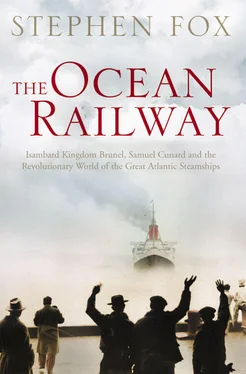1 ...7 8 9 11 12 13 ...38 A few days later, the Herald and Advertiser published a testy letter froma Forth and Clyde Canal proprietor which fleshes out Symington’s later explanation of why his steamboat was banned from the canal. The letter writer pointed out that a vessel passing through one of the canal’s thirty-nine locks used a lockful of water, so a towboat plus barge consumed twice as much water (and the canal had recently been closed by low water); that the Charlotte Dundas, contrary to another report, would save no money over tow horses given her initial expense, the cost of coal, her crew, and general wear and tear; and that Symington’s earlier steamboat of 1801 could not run with any ice in the canal, and this problem had perhaps not yet been solved. After all these objections, the proprietor added, ‘It will be observed too, that the motion of the boat raises such an agitation in the water, as to injure the banks.’ In conclusion – and this probably clinched the matter – the writer regretted that Lord Dundas had been given all the public credit for funding Symington’s efforts. ‘It should have been added, that the Proprietors of the Forth and Clyde Navigation have already paid about £1700. for these experiments of this ingenious mechanic, without reaping any benefit from them, and without even getting any credit for their liberality.’
Given this bristling mixture of unmet criticisms and wounded, unappreciated generosity, and (one may assume) competitive resistance by the local owners of horses and stables, it is not surprising that Symington got no farther with the canal proprietors. Hoping for other wisps of interest in the Charlotte Dundasfrom somebody else, he laid her up near the canal at Bainsford. There she lingered on for almost sixty years, rotting and rusting away, a waning curiosity of the early steam age. Like James Watt, Symington was a gifted inventor saddled with a fainthearted personality, too easily deflected from his purposes. His singular misfortune was that – unlike Watt – he never found his Matthew Boulton.
Robert Fulton, the American painter and inventor, knew all the precedents in steam navigation. During twenty years spent abroad, in England and France, he studied the efforts of other steamboat pioneers and tried out his own improvements. In contrast with most of the other innovators, he was blessed with an overpowering confidence and persistence which, along with good looks and a gift for friendship, brought him the continuing support of rich, powerful patrons. Ultimately he returned to America to build and run the first commercially successful steamboat. Today most Americans consider him the principal originator of steam power on water. The process by which he achieved this reputation – and thus the reputation itself – demands a renewed examination.
For most of his two decades abroad, Fulton was preoccupied with other inventions than a steamboat. Living in France from 1797 to 1804, he devoted himself to an elaborate, quixotic, finally unworkable scheme for submarines and explosive mines, intended to revolutionize naval warfare. His intermittent interest in steamboats was revived when Robert R. Livingston arrived in Paris late in 1801 as the US minister to France. A man of enormous wealth and political influence in New York, Livingston hoped to develop a steamboat service for the Hudson River back home. Fulton had found his final, most significant patron.
During the summer of 1802, Fulton conducted a series of trials with a model boat powered by a clock spring. After considering all the propelling devices used by his predecessors, he settled on an endless chain with paddles or buckets attached to it. Resembling the tread of a modern tank or bulldozer, the chain was draped over two wheels across the side of the model, dipping into and seizing the water at the bottom of its cycle. Livingston, drawing from his own previous sallies at steamboat invention, preferred paddle wheels; but after Fulton reported on his trials with the model, arguing his case quite vehemently, Livingston was converted to the endless chain. In October 1802 the two men signed an agreement to build a large steamboat in New York, designed for the Hudson River traffic to Albany.
Now came a surprising, puzzling twist in the story. At some point that autumn, after insisting so aggressively on the superiority of his endless chain, Fulton decided to adopt paddle wheels as his propelling device. His biographers have guessed that Fulton switched to avoid infringing a French patent, granted earlier that year to an inventor named Desblancs, for a similar steamboat with an endless chain. But Fulton had learned of this patent in June, and as late as September he was nonetheless still urging his own version of an endless chain. Something else must have persuaded him to change this crucial aspect of his design.
A possible explanation was later provided by William Symington. As he told the story in the 1820s, Fulton had come to Scotland to see one of Symington’s vessels, explaining that he intended to return to America to build a steamboat, and that his project could lead to a rewarding business for Symington as the inventor. Flattered and intrigued, Symington ordered steam up in his paddle wheeler and took Fulton and others for a ride. From Lock 18 on the Forth and Clyde Canal, they went four miles west and back in one hour and twenty minutes, at an average speed of six miles an hour – ‘to the great astonishment of Mr. Fulton and the other gentlemen present’, according to Symington. Fulton asked questions, took notes, and made sketches of the steamboat. After this single encounter, Symington recalled, he never saw or heard from Fulton again.
The dating of Fulton’s visit presents problems. Symington placed it in July 1801 or July 1802. In 1801, however, France and England were at war, severely limiting travel between the two countries. Fulton would have had great difficulty in making his way from France to Scotland; at the time he was also still quite focused on his submarine and mines, to the exclusion of other interests. The Peace of Amiens in March 1802 allowed a brief lull in hostilities, easing travel restrictions. By then Fulton, with Livingston’s beckoning patronage, had turned his attention nearly full-time to inventing a steamboat. He spent the summer of 1802 at a resort in the Vosges Mountains of northeast France, too far from the English Channel for a convenient trip to Scotland. That autumn he was back in Paris, intent on his steamboat. The most probable date of Fulton’s encounter with Symington is thus the autumn of 1802, when the Charlotte Dundas was almost ready for her first major trial of January 1803. The journey from Paris took three days to London, then about sixty hours by mail coach to Glasgow. He could have made the round-trip in two weeks.
With travel again flowing between France and England, Paris was full of British tourists from whom Fulton or the widely acquainted Livingston might have heard about Symington’s boat. A trip to England was clearly on Fulton’s mind that autumn. His friend Joel Barlow, also interested in promoting a joint steamboat scheme, had recently urged Fulton to go to England ‘ silent and steady… quiet and quick’ to obtain a steam engine. His formal agreement with Livingston in October also bound Fulton to go ‘ immediately’ to England for the same purpose. Fulton left no surviving record of such a trip at that time. But he could have gone secretly – silent and steady, quiet and quick – on steamboat business, especially to examine the Charlotte Dundas, the most promising such experiment in the world at that time. In late September, he was conspicuously absent from a dinner party given in Paris by the painter Benjamin West. Fultonwas a close friend to West, his main mentor in painting. Joel Barlow and his wife, with whom Fulton lived in a ménage à trois, did attend the dinner. If Fulton had been in Paris, he surely would have joined the party. Perhaps he was then quietly off to Scotland.
Читать дальше












